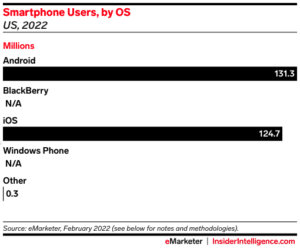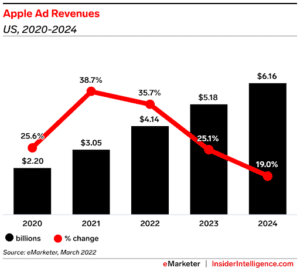Digiday broke the news in early August that Apple is likely working on a DSP (or demand side platform). The tech giant has yet to confirm that they intend to build a platform, but watchful eyes spotted a job opening for a DSP manager to help drive the design on a DSP platform. Apple’s choice to dive into building its demand-side platform is the product of years of finding and capitalizing on profitable ways to keep Apple users within their walled garden of media, apps, and technology. Previously, Apple showcased its ad tech products as “customer-focused.” This messaging, alongside their newest privacy messaging, will likely be present in the design and promotion of the new potential digital advertising initiative.
While there are no clear next steps or features to showcase for this rumored Apple DSP, its advent gives us a hint of what Apple’s focus could be in the coming year and a few suggestions of where new placement opportunities may pop up within their ecosystem. Keeping your eyes on your current technology while looking forward helps build robust and future-proofed marketing and business plans.
📌 What is a DSP in digital marketing?
A DSP or a demand-side platform is a marketing technology software that allows users to purchase advertising spaces across multiple digital locations. These platforms typically enlist the help of automation to enable users to build lists of potential companies and buy advertising placements (on websites, search engines, social media platforms, etc.) at scale.
Why Would Apple Pursue a DSP?
It is no surprise that the tech giant would be interested in creating their Apple DSP, especially considering the current opportunities. This effort aligns with their core privacy messaging from the last several years and, if done correctly, could provide new profit streams from already-established properties. While current ad revenue growth is predicted to decrease, an increase in ad locations could turn this around. There are currently 124.7 million iPhone users in the US.

Privacy Promises Through Settings
In recent years, Apple began aggressively aligning itself as a privacy brand alongside a technology company. The early push to remove cookies from the Safari Browser allowed Apple to tap into crucial concerns for users today. Apple also released privacy settings for iPhone users in June 2021, allowing customers to opt-in or out of app-level privacy settings alongside other changes.
An Apple DSP software that sits within the walled garden of their owned properties will allow Apple to provide users with privacy settings and options, ostensibly protecting their data while still delivering essential products and relevant information. Opportunity certainly exists, but Apple must find an appropriate mix between selling ads and not disrupting customers too aggressively.
💬 What Does Privacy Mean for Digital Marketing? 💬
“Throughout the next few years, digital advertising options will continue to evolve with the emerging demands for more and more privacy. These demands clear the way for new tools to enter the space. Marketers must plan on testing and iterating as the rules and options change. Prepare to pivot as new audiences, new social media platforms, and new marketing options appear.”
–Eric Lee, Co-Founder & Managing Partner, KORTX
Ad Space Options, Vast First-Party Data Available
Currently, Apple showcases ads on their news and stock apps and displays ads within the app store’s search function. These placements would be easy to build upon in other apps.
Apple owns multiple properties where ads could be showcased alongside the content. The app store, for example, already includes advertising opportunities for app creators. Apple TV is already poised to follow in the footsteps of streaming services such as Netflix, Hulu, and YoutubeTV, including advertiser options. As of October 12, 2022, Apple began quietly pushing a TV ad product with top media agencies. This release will likely come in the first half of 2023.
Other locations could include owned apps such as Books, Music, Podcasts, and Maps. Alongside these locations, Apple possesses a large amount of First-Party Data through Apple IDs required for all app-enabled devices.

Pros and Cons of an Apple DSP
There are pros and cons to Apple creating a DSP. With each new DSP option or ad tech advance, digital media buyers must weigh the cost of a new product compared to the efficacy of their current efforts.
👍 Pros
- New Inventory – If Apple decides to open up its various apps and programs to ads, these locations could be excellent locations for client placements. The maps app, for example, could easily be used to direct users to new QSR locations.
- Streaming TV Placement: Apple TV has grown significantly over the past few years to 38.7 million subscribers and will likely continue to do so.
- First-Party Data Options – Depending on how advanced and how much user data Apple is willing to use, the user data could prove unmatched in a cookie-less world, efficiently targeting specific areas or serving ads to listeners of relevant podcasts.
👎 Cons
- Limited DSP Audiences – There is a fair chance that Apple’s DSP solution will be specific to users in the Apple ecosystem. While these numbers are growing, this likely will not compete with DSPs with much larger audiences.
- Data Integration and Sharing – Traditionally, Apple products and tools do not play nicely with other platforms or integrations. This disconnect may also be the case with the upcoming DSP, causing cross-platform and holistic reporting complications and further limiting marketers’ understanding of their full scope of efforts.
Does Apple have a DSP?
Apple does not currently have a DSP (demand-side platform.) The tech giant is working on building its marketing technology. Apple’s DSP will likely launch in the next few years.
What kind of ads will be available on an Apple DSP?
A DSP from Apple will likely sell advertising placements across Apple’s owned entities and properties. Currently, ads are available within the News and Stocks apps, as well as the search function in the app store. Other locations will likely include Apple TV alongside apps such as Books, Music, Podcasts, and Maps.
KORTX can help!
Need a partner who knows how to use data to make intelligent marketing decisions about DSPs and ad placement? KORTX has the tools and the people to make the most of your marketing.
|
Sources:
- https://www.adexchanger.com/mobile/why-would-apples-idsp-succeed-when-iad-failed/
- https://adage.com/article/digital-marketing-ad-tech-news/how-apples-secretive-ad-tech-strategy-goes-beyond-search-ads/2425651
- https://digiday.com/media/apple-is-building-a-demand-side-platform/
- https://www.theverge.com/2022/8/14/23305200/iphone-more-ads-advertising-apple-maps-podcasts-books-mark-gurman-rumors
- https://content-na1.emarketer.com/apple-could-soon-bring-ads-apple-maps-books-podcasts
